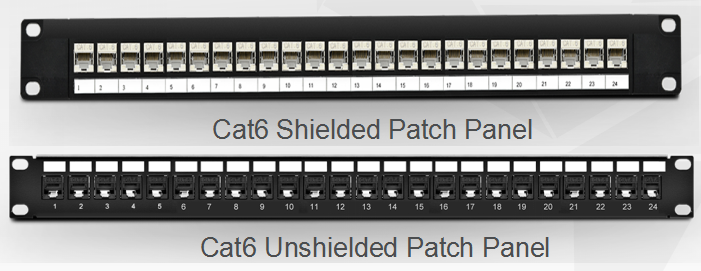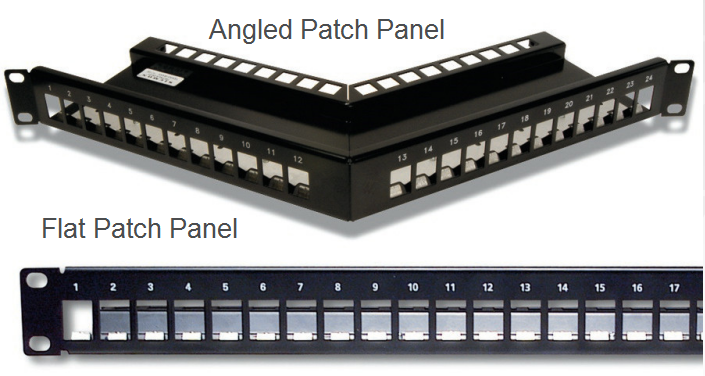- به وبلاگ خود خوش امدید
- Analysis of A Practical CWDM System Deployment Case
- Why Not Use EDFA Amplifier in Long CATV Network?
- Why Not Using DWDM Technology to Build Your Network?
- Optical Transponder—an Important Component in WDM System
- How to Build an Economical Long-haul 500Gbps Metro Network?
- Fiber Optical Communication
- Why Do We Need Optical Transponder (O-E-O)?
- CWDM Technology—Economically Saving Fibers for Your Network
- Confused About Loss in the Long Haul DWDM Network?
آخرین مطالب
امکانات وب
With the rapid development of the network technology, the network deployment becomes much more complicated than ever before to satisfy the increasing network needs. In order to deploy the the complicated cabling network in a tidy, fast and correct manner, the patch panel is designed to better manage the patch cables in the network, which can be divided into two types, the copper patch panel and the fiber patch panel. To avoid the connection errors and making the cabling network flexible, reliable and neat, this paper will mainly introduce some commonly used types of the copper patch panel that may be helpful for you to pick the most suitable one for your cabling network.
While the copper patch panel has made a great contribution to the complicated cabling network as a cost effective solution, the type of the copper patch panel has become more and more diversified, such as, shielded and unshielded patch panel, flat and angled patch panel, common and high density patch panel, classified according to the designed aspect. The following will discuss the details of these four types of commonly used copper patch panels.
Shielded vs. Unshielded Patch Panel
Since the performances of the shielded and unshielded patch panel are different from each other, you should consider that should the patch panel be shielded or unshielded to fit your network before ordering the copper patch panel. Besides, you may also wonder that can you use the shielded patch cable with an unshielded patch panel or the unshielded patch cable with a shielded patch panel? Letrsquo;s explore these questions and seek the answers.
There is no doubt that the shielded patch panel performs higher than the unshielded one, because the shielded feature enhances the anti-interference performance of the copper patch panel and protects the high speed network from noise and EMI (Electro Magnetic Interference). Considering that the interference is really a risk for the network that may cause transmission errors or failures, the unshielded patch panel is designed for the common applications where the EMI is not very high, while the shielded patch panel is more suitable to be used in the environments with high EMI. Besides, you can also select the patch panel according to the network speed. Moreover, if your network is a 1G Ethernet network, then both the shielded and unshielded patch panel can be chosen. But if the network is a 10G Ethernet network, then you are highly suggested to choose the shielded one. For better know the two types of patch panels, here offers a figure that shows the structural difference between the Cat6 shielded patch panel and the Cat6 unshielded patch panel.

Can you use the shielded patch cable with an unshielded patch panel? It relies on the network environment. In simple words, if there are no high power electrical wires in the network, then you can use the unshielded patch panel. But if arc welders, high power radio transmitters or other high power electrical equipment near the network, you should better go with the shielded patch panel. As for using the unshielded patch cable with an shielded patch panel, it is OK in theory but unnecessary in practice. Because the shielded patch panel is much expensive than the unshielded patch panel.
Flat vs. Angled Patch Panel
On the basis of the appearance design, the copper patch panel can be classified into flat and angled patch panel, as shown in the following figure. The flat patch panel enables the horizontal cabling and routes the cables into vertical cabling, while the angled patch panel makes the cable termination easy and patch cord routing improved. Compared with the former one, the angled design of the latter one increases the rack density, managing high-density applications in one-fourth the area needed for conventional cable management systems. But taking the front depth requirements of the angled patch panel into account, the angled patch panel is not so good for the cabinet installation as the flat patch panel.

Common vs. High Density Patch Panel
As there are often 8 or 12-port configurations on the common patch panel, the high density patch panel is usually designed with 24 or 48 ports as an ideal solution for the applications where there is limited space. Since there are much more ports in the high density patch panel to connect and manage the incoming and outgoing Ethernet cables, it has the ability to conserve the rack space. Hence, if the space is limited in your network, then you can choose the high density patch panel to deploy your network cabling.
After discussion, it can be concluded that the unshielded patch panel is suitable for the applications where the EMI is not very high, while the shielded patch panel is more commonly used in the environments with high EMI. It can be also concluded that the flat patch panel is a good choice if you want to easily deploy the patch panel. Otherwise, the angled patch panel is highly suggested. Besides, if there is limited space in your network, you are recommendable to choose the high density patch panel rather than the common one for conserving space. For easier network deployment and better cabling management, yoursquo;d better pick the most suitable patch panel for your cabling network.
Fiber Optical Communication...برچسب : نویسنده : afiberopticalcom1 بازدید : 60
لینک دوستان
- کرم سفید کننده وا
- دانلود آهنگ جدید
- خرید گوشی
- فرش کاشان
- بازار اجتماعی رایج
- خرید لایسنس نود 32
- هاست ایمیل
- خرید بانه
- خرید بک لینک
- کلاه کاسکت
- موزیک باران
- دانلود آهنگ جدید
- ازن ژنراتور
- نمایندگی شیائومی مشهد
- مشاوره حقوقی تلفنی با وکیل
- کرم سفید کننده واژن
- اگهی استخدام کارپ
- دانلود فیلم
- آرشیو مطالب
- فرش مسجد
- دعا
- لیزر موهای زائد
- رنگ مو
- شارژ
